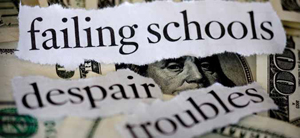Fed Funding Update: Where Did the Money Go?

A portrait of school improvement grantees
By Padmini Jambulapati
In the last year, the federal government has invested $3.5 billion dollarsin an effort to fix the nation’s bottom 5 percent of public schools. In the coming months, it will roll out another $546 million dollars to do the same. The initiative is known as the School Improvement Grant, or SIG, program. It is the largest pot of federal funds ever aimed at improving a discrete set of the worstperforming schools.
The SIG program is not the first federal investment in fixing low-performing schools, but it does represent a new approach, one that, if the Obama administration prevails, will find its way into the long overdue reauthorization of the Elementary and Secondary Education Act. Whereas the No Child Left Behind Act relies exclusively on absolute measures of proficiency to measure school performance, SIG allows states to choose their most troubled schools based on their own formulas that combine absolute proficiency with measures of student learning growth over time. School districts then compete for SIG funds, unlike the more typical formula-based distribution of dollars under Title I of ESEA.
SIG grantees are eligible for up to an unprecedented $6 million dollars per school over a three-year period to implement one of four prescribed models: school closure, restart as a charter school, turnaround through replacing the principal and 50 percent of the instructional staff, or transformation, which requires implementing a slate of reforms. None of the SIG reform models has an unvarnished track record, and none has been implemented at this scale. The timelines for implementation and improvement are demanding and, given the history of federal school turnaround efforts, arguably unrealistic.
So far, 843 schools from 49 states and the District of Columbia have been selected as SIG grantees, and the combined grants are expected to serve 594,117 students. What do these schools look like? What reform models have they chosen?
A closer look at SIG schools
Tools and ideas to transform education. Sign up below.
In their applications to the federal Department of Education, state education agencies compiled a list of the lowestperforming schools based on self chosen (but approved by the department) definitions that combined growth and achievement. They had to prioritize and sort these schools into three different tiers.
Tier I represents the lowest-achieving 5 percent of Title I schools or the five lowest-performing Title I schools in some stage of improvement or restructuring under NCLB, whichever number was higher. Tier II includes schools that are Title I–eligible, but do not receive funds. This category was meant to deliberately include high schools and middle schools that often do not receive funds in district distribution, but are technically eligible to get them. Tier III includes the remaining Title I schools that were in improvement or restructuring, but were not identified as Tier I and Tier II schools. The grant requires states and districts to fund Tier I and Tier II schools first, in order to ensure that the lowestperforming schools receive funds first.
Nationwide, many SIG grantees look a lot like the schools that typically receive the majority of federal dollars—large, low-performing, traditional public schools that are highly segregated, lowincome, and in urban areas. Of the 843 SIG schools across the country, more than half have African-American/Latino populations that are 86 percent or higher; the median free/reduced lunch rate is 78 percent; and around 58 percent of the schools are located in urban areas.
But that is not the complete picture of America’s lowest-performing schools. A substantial proportion of schools are in rural (18 percent) or suburban (17 percent) areas or in towns (7 percent). 6 (See Chart 1.)
The SIG program signals a shift toward prioritizing high-poverty rural schools. Typically, rural schools receive fewer Title I dollars than their urban counterparts because funding formulas favor wealthier states with larger urban districts. While urban schools have greater access to programs like private foundation grants and urban-specific programs, rural schools, often located in the poorest school districts, lack the capacity and resources to tackle expensive large-scale school reform.
Generally, larger schools are associated with poorer student performance, but the distribution of school enrollment numbers varied among the grantees. The average student enrollment for a SIG grantee is 704 students. While 176 grantees— mostly high schools—enroll more than 1,000 students, 41 grantees enroll fewer than 100 students. Almost half (49 percent) of the SIG recipients are high schools.
A Few Surprises
Most SIG grantees are traditional public schools, but the 843 schools selected so far also include 56 charter schools in 15 states. Charter schools are often touted as the solution to fixing low-performing schools. They are granted greater autonomy, or the ability to implement a variety of reforms, in exchange for greater accountability and sanctions. Thus, in theory, it should not only be easy to shut down a low-performing charter, but it should be expected that low-performing charters will be closed. Yet, the presence of charter schools among a state’s worst performers illustrates the variability in their performance. And their presence among SIG grantees illustrates an overall resistance to closing schools, regardless of how or by whom they are governed. Notably, of the 56 charter schools receiving funds, 22 (nearly 40 percent) are charter schools from Texas, which has seen tremendous growth in charter schools over the last decade, but also varying degrees of performance.
In the coming months, districts will apply for funds and a whole new slate of schools will be identified, likely mirroring the current profile of grantees. Whether or not the worst of the worst schools can turn themselves around is yet to be seen. But the Obama administration is banking on it, all in hopes that targeting the “hot spots,” or public education’s neediest schools, could spark enough change in actors throughout the system—teachers, principals, students, and parents— to alter the system as a whole.
Padmini Jambulapati is a research assistant at Education Sector, an independent think tank. This article, A Portrait of School Improvement Grantees, is reprinted with permission from Education Sector. Read more at www.educationsector.org.
Where does the money go?
How schools are using tech to save money.
Go Digital and Become More Efficient

Problem: The English teachers at Air Academy High School at the U .S. Air Force Academy in Colorado wanted to put an end to plagiarism.
Solution: Using Google to search for excerpts from student papers did not work well, so the teachers turned to Turnitin. “We wanted to find a comprehensive program that would allow us to check for originality, keep electronic copies of student papers, manage paper load, and easily transfer student work from year to year,” says English teacher Heather Scott. Turnitin lets her grade papers up to 70 percent quicker, be more organized, and cut back significantly on paper usage, she says.
When Monitors Go Green, Everyone Wins


Problem: Judson (Texas) Independent School District wanted to increase computer access while simplifying installation and support, even though its budget was tight and its IT staff limited.
Solution: The district had already deployed thin clients, so it was encouraged when it discovered that LG Network Monitors allow schools to run 11 monitors through one computer. Each monitor works independently of the rest (each student can run a different program, content, etc.), and the system was designed for schools whose IT budgets have been cut but that still want to offer the most up-to-date technology. After putting LG Network Monitors in classrooms, computer labs, and libraries, Judson ISD cut computer acquisition costs 50 percent, made IT staff more productive, cut electricity costs 70 percent, and reduced network infrastructure costs.
Energy Upgrades = Extraordinary Financial Savings


Problem: The Pearl River (N.Y.) Union Free School District wanted to gain more control of its energy costs by upgrading the energy infrastructure of its schools.
Solution: Pearl River turned to Ameresco, Inc. to implement a $4.2 million project, based on an energy savings performance contract, that includes upgrades of a total of 390,064 square feet of space and requires no up-front capital costs to the district, which expects to save more than $6.4 million over the course of the 18-year project.
Perfecting a Print Strategy Saves Thousands of Dollars
Problem: The Kansas City (Mo.) School District was desperate to reduce the $2.4 million it was spending on print, office products, furniture, and janitorial products.
Solution: The district partnered with OfficeMax to outsource on-site printing, consolidate office supplies, and implement a managed-print-services strategy and a technology-workflow solution. I n doing so, Kansas C ity reduced annual cost per pupil from $28 to $22, a 22 percent savings, and it expects to save $682,000 annually.
Consolidate Printing, Save Trees, and Cut Costs Significantly

Problem: The Park Hill School District in Kansas City, Missouri, which serves 10,000 students at 15 schools, wanted to make its printing operations more effective and save money.
Solution: By using Equitrac printmanagement software to consolidate devices and enforce print quotas, Park Hill saved more than $15,000. In addition, the district reduced print output by more than 500,000 pages (that’s 60 trees!) and is now able to budget accurately for print expenses each month.
